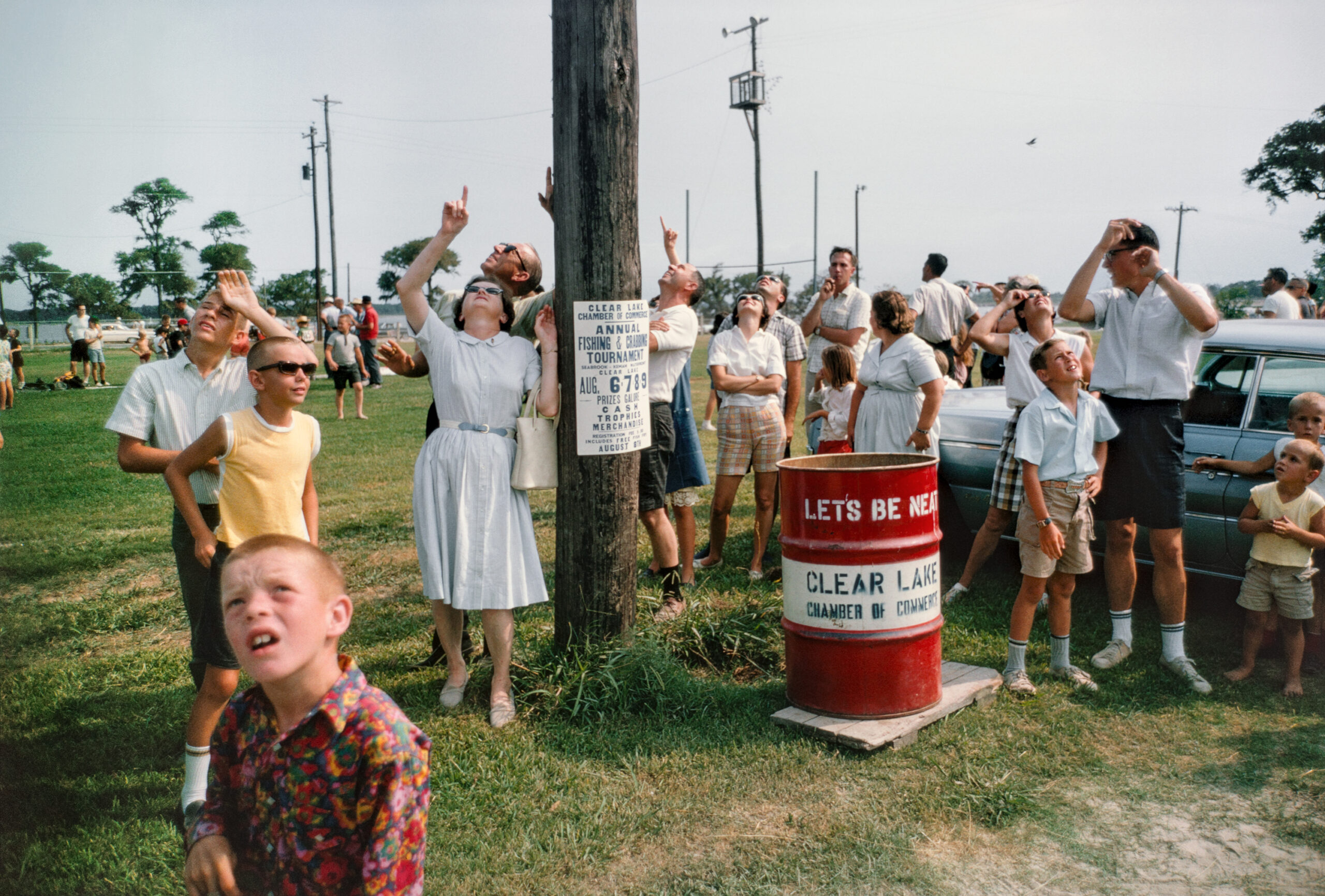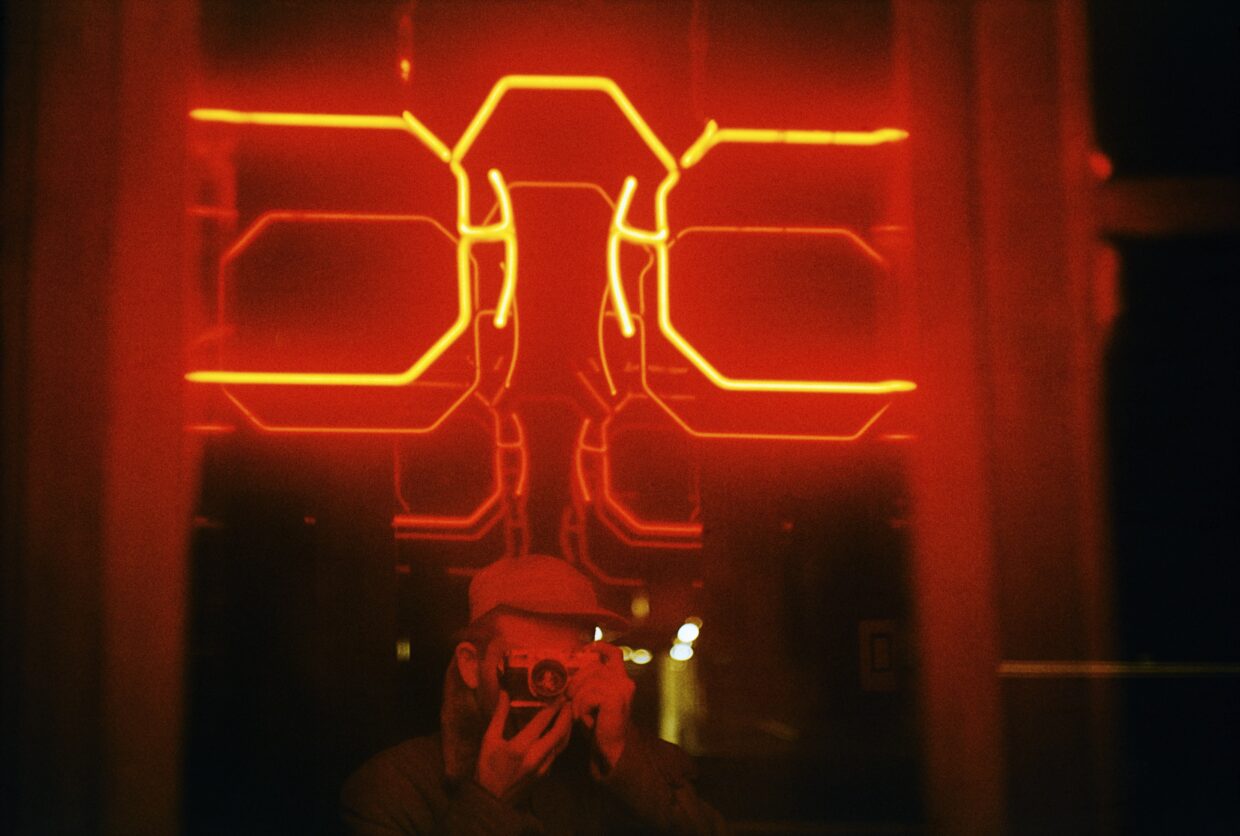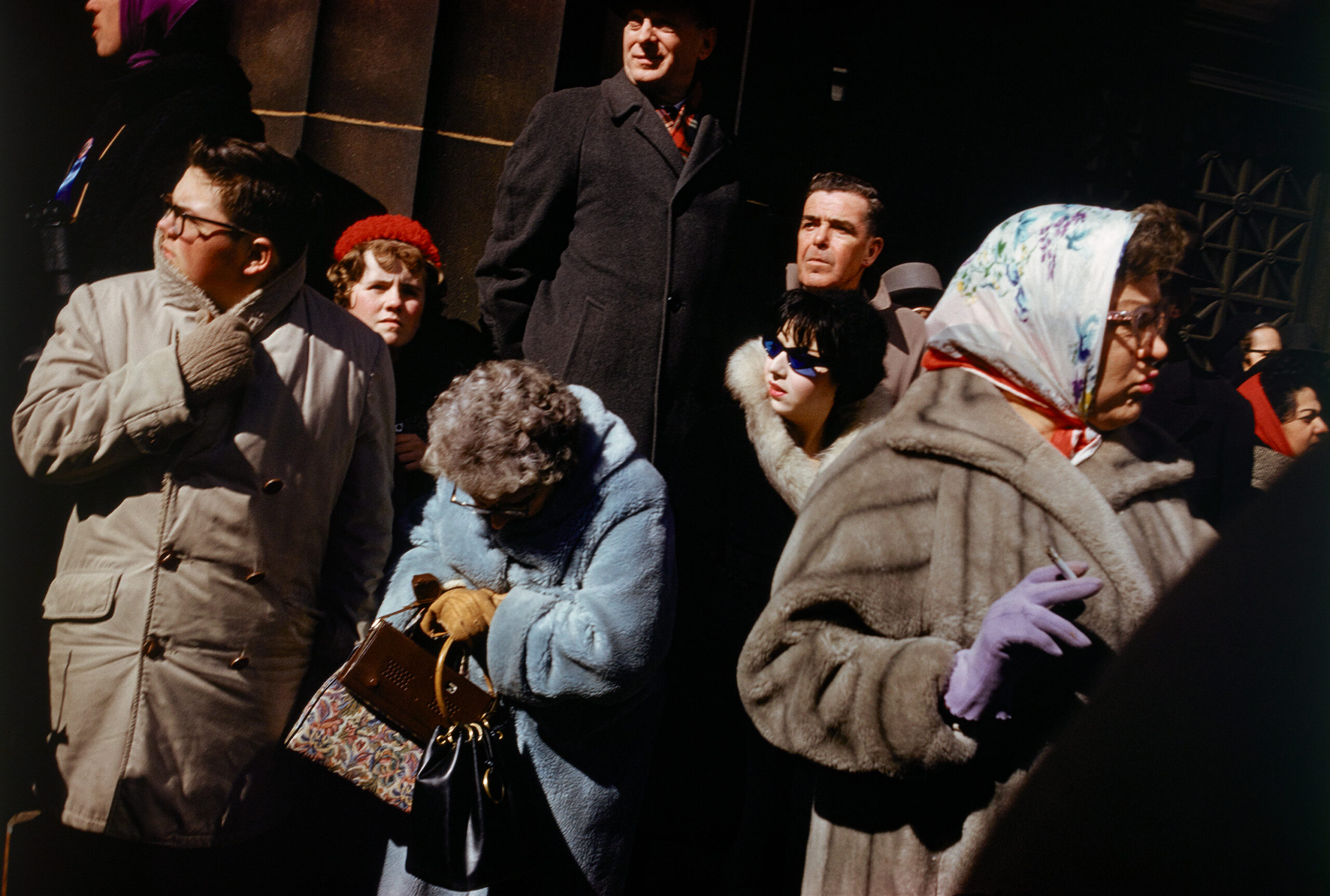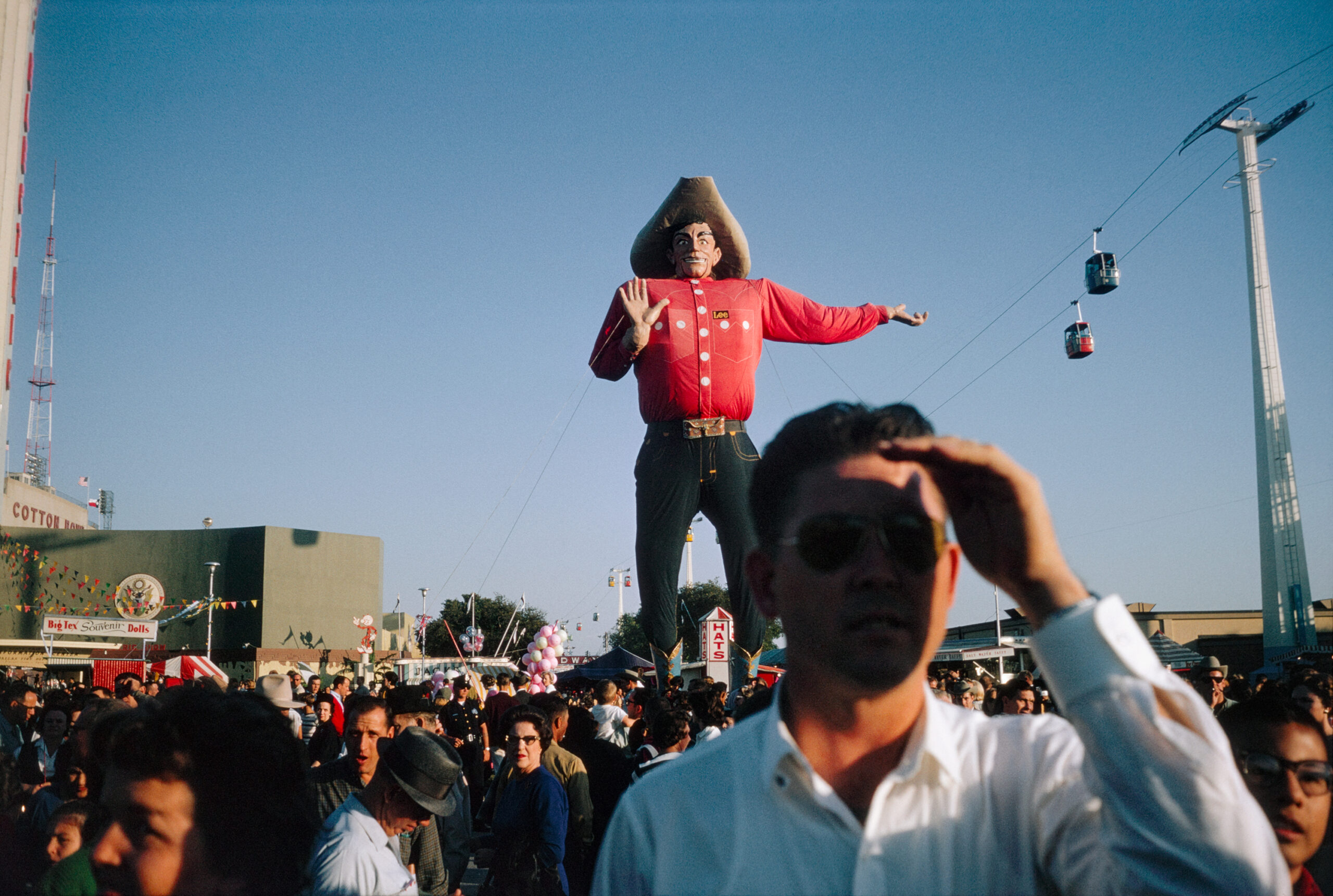
The Rarely Seen Color Photographs of Garry Winogrand
Michael Almereyda on the Famed Photographer’s Use of Color
Feature image: Houston, Texas, 1964. © The Estate of Garry Winogrand, courtesy of Fraenkel Gallery, San Francisco and Twin Palms Publishers.
I saw Garry Winogrand deliver a slide lecture—a string of intermittent, axiomatic comments—at Fordham University in 1982. Winogrand was, I recall, a cheerful, broad-bodied man projecting a quality of laconic bravado. He was both reticent and loud. His axioms were rehearsed, available to anyone who had read his interviews—“I photograph to find out what some-thing will look like photographed” and “There is nothing as mysterious as a fact clearly described”—and the slides he clicked through were his classic black-and-white pictures covering a range of periods and places.
Most of the images shuttled by without verbal accompaniment; he was assured enough to let pictures speak for themselves. Near the end of the proceedings I raised a hand and asked if there had been any kind of continuity between the photos he took while working on commercial jobs and the personal pictures we were looking at now. (I was thinking about Walker Evans, one of Winogrand’s avowed heroes, and how a recent exhibition had directed attention to the fact that some of Evans’s most personal, eventually iconic images originated as assignments for Fortune magazine.)
 Garry Winogrand (self-portrait), New York City, c. 1955–58. © The Estate of Garry Winogrand, courtesy of Fraenkel Gallery, San Francisco and Twin Palms Publishers.
Garry Winogrand (self-portrait), New York City, c. 1955–58. © The Estate of Garry Winogrand, courtesy of Fraenkel Gallery, San Francisco and Twin Palms Publishers.
Winogrand’s response was like a wind blasting back in my face. He denied any connection between commercial assignments and personal photographs. He had no respect for advertising and magazine work, dismissing the culture and climate by which he had barely earned a living during his early professional life. “These people,” he concluded with a scornful smile, “give themselves awards!”
The 45,000 Kodachrome and Ektachrome slides (roughly counting) that Winogrand shot between the early 1950s and late 1960s were often taken between assignments, when the photographer, working on his own, developed and refined an approach to his medium that was increasingly open, independent, and radical. He routinely photographed with two cameras strapped around his neck, one loaded with color film, the other with black and white. He was often, plainly, primed to feed an ad agency’s appetite for stock imagery. The Center For Creative Photography in Tucson, Arizona, where the mass of Winogrand’s work is archived, could provide content for multiple Garry Winogrand color calendars featuring pictures you’d never dream were taken by Winogrand: views of glittering streams, unpeopled oceans, midwest-ern roads in diminishing perspective, and sunsets galore. But the best of his color work—a high quotient of which, we’d like to think, is collected here—reflects an aesthetic resourcefulness, and a view of the world, that’s specifically human-centered, and can be as urgent, assured and unexpected as Winogrand in black and white.
 New York City, 1962. © The Estate of Garry Winogrand, courtesy of Fraenkel Gallery, San Francisco and Twin Palms Publishers.
New York City, 1962. © The Estate of Garry Winogrand, courtesy of Fraenkel Gallery, San Francisco and Twin Palms Publishers.
The slides feature a terrific variety of characters: families, couples, lone figures and crowds in public and private spaces, people displaying self-possession and unease in equal measure. As Ingrid Sischy has written, Winogrand had a gift for distilling and describing the American psyche in intimate detail, and his color work presents a cumulative chronicle, revealing a land of promise and disappointment, emptiness and glut, anxiety and joy.
 New York City, 1967. © The Estate of Garry Winogrand, courtesy of Fraenkel Gallery, San Francisco and Twin Palms Publishers.
New York City, 1967. © The Estate of Garry Winogrand, courtesy of Fraenkel Gallery, San Francisco and Twin Palms Publishers.
I ventured to Tucson with my friend Susan Kismaric, who had been a curator in the Department of Photography at New York’s Museum of Modern Art for thirty-five years. Sorting through the CCP collection, we were looking for needles in a vast archival haystack—tens of thousands of images, boxes within boxes of largely unscanned, obscurely organized color slides in their original cardboard mounts. We spent four weeks at it, spread across three trips, between June 2016 and August 2017. Susan, wearing latex gloves, would array a dozen or so slides on a compact lighttable and we’d take turns leaning in to look through a magnifying loupe. A selected slide was then slotted into a separate viewer, and I hovered with an iPhone to make an inventory. The airless confines of the study center, the limited hours available to us, and the expected but nevertheless overwhelming too-muchness of Winogrand’s approach left us more than a little weary, if not, at times, stupefied, but there was an exciting yield of strong, striking, even fascinating pictures—images previously unpublished, utterly unknown.
 White Sands National Monument, New Mexico, 1964. © The Estate of Garry Winogrand, courtesy of Fraenkel Gallery, San Francisco and Twin Palms Publishers.
White Sands National Monument, New Mexico, 1964. © The Estate of Garry Winogrand, courtesy of Fraenkel Gallery, San Francisco and Twin Palms Publishers.
The idea for Winogrand Color was triggered by thirty tantalizing color photographs in Trudy Wilner Stack’s Winogrand 1964—published in 2002, long out of print—a remarkable book placing Winogrand’s color work alongside ninety black-and-white pictures made in a profoundly productive, Guggenheim-sponsored period of cross-country car trips throughout the United States. One of his very few written statements, Winogrand’s Guggenheim application—submitted in the wake of the Cuban Missile Crisis, which had plunged him into despair—has been frequently and extensively quoted for good reason. The sentiments confided by the 35-year-old photographer remain relevant for anyone trying to confront anguish over the clash of commerce and culture, fantasy and reality, in contemporary America:
I look at the pictures I have done up to now, and they make me feel that who we are and what we feel and what is to become of us just doesn’t matter. Our aspiration and successes have been cheap and petty. I read the newspapers, the columnists, some books. I look at the magazines (our press). They all deal in illusions and fantasies. I can only conclude that we have lost ourselves, and the bomb may finish the job permanently ,and it just doesn’t matter, we have not loved life.
Winogrand’s transition here from “I” to “we” tracks a lunge of empathy and self-criticism that few grant applicants, I’m guessing, would be inclined to risk, and his next sentence feels equally, bitterly brave: “I cannot accept my conclusion, and so must continue this photographic investigation further and deeper.”
 New York City, 1966. © The Estate of Garry Winogrand, courtesy of Fraenkel Gallery, San Francisco and Twin Palms Publishers.
New York City, 1966. © The Estate of Garry Winogrand, courtesy of Fraenkel Gallery, San Francisco and Twin Palms Publishers.
Before Wilner Stack’s book, there was precious little public evidence that Winogrand’s “investigation” involved a true engagement with color, though the photographer’s foremost curatorial champion, John Szarkowski, chose to project eighty of Winogrand’s color slides in New Documents, the Museum of Modern Art’s landmark 1967 show in which Winogrand, Diane Arbus, and Lee Friedlander each exhibited thirty-two black-and-white prints, filling separate galleries with work declaring a generational shift in the history of the medium. Szarkowski was aware of the pessimism inflecting Winogrand’s work—Szarkowski was, for years, the undeclared judge and administrator of the Guggenheim Fellowship for photography; he awarded Winogrand the validating grant—but his show’s wall text downplayed the inner agitation informing the pictures on display, offering a brighter, more suggestive summary of what the three artists were up to:
Their work betrays a sympathy —almost an affection — for the imperfections and frailties of society. They like the real world, in spite of its terrors, as the source of all wonder and fascination and value. . . . What they hold in common is the belief that the commonplace is really worth looking at, and the courage to look at it with a minimum of theorizing.
 State Fair of Texas, Dallas, 1964. © The Estate of Garry Winogrand, courtesy of Fraenkel Gallery, San Francisco and Twin Palms Publishers.
State Fair of Texas, Dallas, 1964. © The Estate of Garry Winogrand, courtesy of Fraenkel Gallery, San Francisco and Twin Palms Publishers.
A couple of weeks into the exhibition, a malfunctioning projector burned eleven of Winogrand’s slides, resulting in the removal of the carousel and the termination of Winogrand’s official identity as a color photographer. He continued to shoot in color but less frequently, never printing, exhibiting, or publishing the pictures, his color output dwindling significantly in the late 1960s.It seems to have boiled down to a matter of cost. Sasha Waters Freyer’s captivating 2018 documentary, Garry Winogrand: All Things Are Photographable, contains a 1977 audio recording of Winogrand talking in a restaurant with photographer Jay Maisel, asserting in a confident yammer that when the technology of color photography catches up with him, when he can afford to print as many color pictures as he’s inclined to shoot, he would continue with color in earnest.
 Coney Island, New York City, c. 1952–58. © The Estate of Garry Winogrand, courtesy of Fraenkel Gallery, San Francisco and Twin Palms Publishers.
Coney Island, New York City, c. 1952–58. © The Estate of Garry Winogrand, courtesy of Fraenkel Gallery, San Francisco and Twin Palms Publishers.
Winogrand died on March 19, 1984 age fifty-six, succumbing to cancer within six weeks of its initial diagnosis. Nearly forty years later, his depiction of the American experience—in Szarkowski’s words “the fabric and texture of our life since Truman”—is often compared to a novelist’s multivolume outpouring, with Norman Mailer and Philip Roth registering as plausible literary counterparts. Indeed, few writers or photographers can be said to match Winogrand’s passionately alert, omnivorous observation of the country’s surface turmoil and unsettled nerves, the sense of a panoramic national portrait. But it’s also possible to see in Winogrand’s color—in the brighter, often blazing, sun-splashed subjects and scenes—a temperament that’s less raucous or savage.
Vladimir Nabokov’s Lolita comes to mind, and the Russian master’s other American novels, filled with tender descriptions of what John Updike termed “our monstrosity.” Nabokov, Updike wrote, reveals “not only the landscape—the eerily arboreal suburbs, the grand emptiness, the exotic and touchingly temporary junk of roadside America—but the wistful citizens of a violent society desperately oversold, in the absence of other connections, on love.” Winogrand’s color work confronts us with a similarly intimate, flashing mirror, disclosing yearning and loss within American commotion and plenitude, all the while serving up sharp glimpses of the commonplace—the face of a sleeping boy gilded with Coney Island sand, a young woman’s profile suspended over a half-eaten plate of eggs—that cross into the realm of lyric contemplation.
___________________________

From Garry Winogrand: Winogrand Color, edited by Michael Almereyda, Susan Kismaric. Afterword by Michael Almereyda. Text copyright by Michael Almereyda, 2024. Used with permission of the publisher, Twin Palms Publishers.
Michael Almereyda
Michael Almereyda’s films include Hamlet, William Eggleston in the Real World, Experimenter, Marjorie Prime, and Tesla. He has written for The New York Times, Film Comment, and The Criterion Collection, and is the editor of William Eggleston, For Now, a book of previously uncollected photographs.












